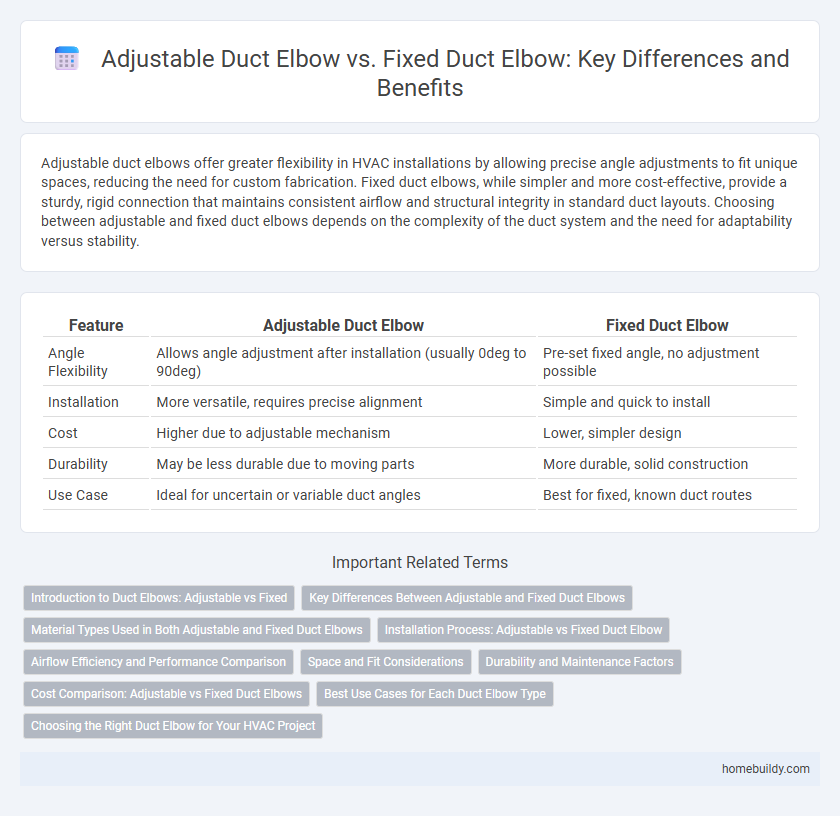Adjustable duct elbows offer greater flexibility in HVAC installations by allowing precise angle adjustments to fit unique spaces, reducing the need for custom fabrication. Fixed duct elbows, while simpler and more cost-effective, provide a sturdy, rigid connection that maintains consistent airflow and structural integrity in standard duct layouts. Choosing between adjustable and fixed duct elbows depends on the complexity of the duct system and the need for adaptability versus stability.
Table of Comparison
| Feature | Adjustable Duct Elbow | Fixed Duct Elbow |
|---|---|---|
| Angle Flexibility | Allows angle adjustment after installation (usually 0deg to 90deg) | Pre-set fixed angle, no adjustment possible |
| Installation | More versatile, requires precise alignment | Simple and quick to install |
| Cost | Higher due to adjustable mechanism | Lower, simpler design |
| Durability | May be less durable due to moving parts | More durable, solid construction |
| Use Case | Ideal for uncertain or variable duct angles | Best for fixed, known duct routes |
Introduction to Duct Elbows: Adjustable vs Fixed
Adjustable duct elbows offer flexibility in angle adjustment, making them ideal for complex HVAC duct routing where precise alignment is needed. Fixed duct elbows provide a set angle, typically 45 or 90 degrees, ensuring consistent airflow direction in straightforward duct systems. Selecting between adjustable and fixed duct elbows depends on project requirements, installation complexity, and desired airflow efficiency.
Key Differences Between Adjustable and Fixed Duct Elbows
Adjustable duct elbows offer flexibility in installation by allowing angle modifications, accommodating varying duct layouts, whereas fixed duct elbows have a predetermined angle that cannot be altered. Fixed duct elbows typically provide improved airflow efficiency and durability due to their rigid construction, while adjustable elbows may introduce minor airflow resistance because of their joint mechanisms. Choosing between adjustable and fixed elbows depends on the specific HVAC system requirements, space constraints, and the need for future duct modifications.
Material Types Used in Both Adjustable and Fixed Duct Elbows
Adjustable duct elbows are commonly made from galvanized steel, aluminum, or stainless steel, offering flexibility in length and angle adjustments for HVAC systems. Fixed duct elbows typically use galvanized steel or PVC, providing robust, durable connections with fixed angles for consistent airflow direction. Both types prioritize corrosion resistance and strength, with material selection based on application requirements such as indoor or outdoor usage and exposure to moisture.
Installation Process: Adjustable vs Fixed Duct Elbow
Adjustable duct elbows offer flexible installation by allowing angle modifications on-site, reducing the need for precise pre-measurements and minimizing labor time. Fixed duct elbows require accurate pre-planning and precise cutting to fit specific angles, often resulting in longer installation times and potential adjustments. The adaptability of adjustable elbows streamlines the installation process, especially in complex ductwork layouts.
Airflow Efficiency and Performance Comparison
Adjustable duct elbows offer enhanced airflow efficiency by allowing precise angle modifications to reduce turbulence and resistance, optimizing air distribution in HVAC systems. Fixed duct elbows, while simpler and often more cost-effective, may cause increased pressure loss and airflow disruption due to their static design, limiting performance adaptability. Choosing adjustable elbows improves system performance by minimizing energy consumption and maintaining consistent airflow rates across varying installation requirements.
Space and Fit Considerations
Adjustable duct elbows offer greater flexibility in tight or irregular spaces, allowing precise angle modifications that ensure an optimal fit within complex HVAC layouts. Fixed duct elbows require accurate measurements and predetermined angles, often necessitating additional space to accommodate installation adjustments. Selecting adjustable elbows reduces the risk of system inefficiencies caused by misalignment, making them ideal for confined or variable duct routing conditions.
Durability and Maintenance Factors
Adjustable duct elbows offer enhanced durability by accommodating changes in duct alignment without causing stress or damage to the joints, reducing the need for repairs compared to fixed duct elbows. Fixed duct elbows, while generally sturdy, can suffer from wear and tear at fixed angles that may require more frequent maintenance or replacement when system configurations change. Maintenance for adjustable elbows is simplified due to their flexibility in installation and repositioning, leading to lower long-term costs and improved system longevity.
Cost Comparison: Adjustable vs Fixed Duct Elbows
Adjustable duct elbows typically incur higher upfront costs than fixed duct elbows due to their versatile design and ability to fit various angles, reducing the need for additional components during installation. Fixed duct elbows offer a more budget-friendly solution, particularly in projects with standard duct angles, resulting in lower material and labor expenses. The choice between adjustable and fixed duct elbows impacts overall project costs, with adjustable elbows providing flexibility at a premium and fixed elbows delivering cost-efficiency in predictable ductwork layouts.
Best Use Cases for Each Duct Elbow Type
Adjustable duct elbows are ideal for HVAC systems requiring precise directional changes and flexibility during installation or future modifications, as they allow for customizable angles between 0deg and 90deg. Fixed duct elbows are best suited for standard applications with predetermined angles, offering greater durability and lower cost in permanent ductwork layouts. Selecting between adjustable and fixed duct elbows depends on space constraints, installation complexity, and the need for future system adjustments.
Choosing the Right Duct Elbow for Your HVAC Project
Adjustable duct elbows provide flexibility in directing airflow at various angles, making them ideal for complex HVAC layouts requiring precise alignment. Fixed duct elbows offer a sturdy, cost-effective solution for standard, predetermined angles where adjustments are unnecessary. Selecting the right duct elbow depends on project complexity, space constraints, and airflow requirements to optimize system efficiency and installation ease.
Adjustable duct elbow vs Fixed duct elbow Infographic

 homebuildy.com
homebuildy.com